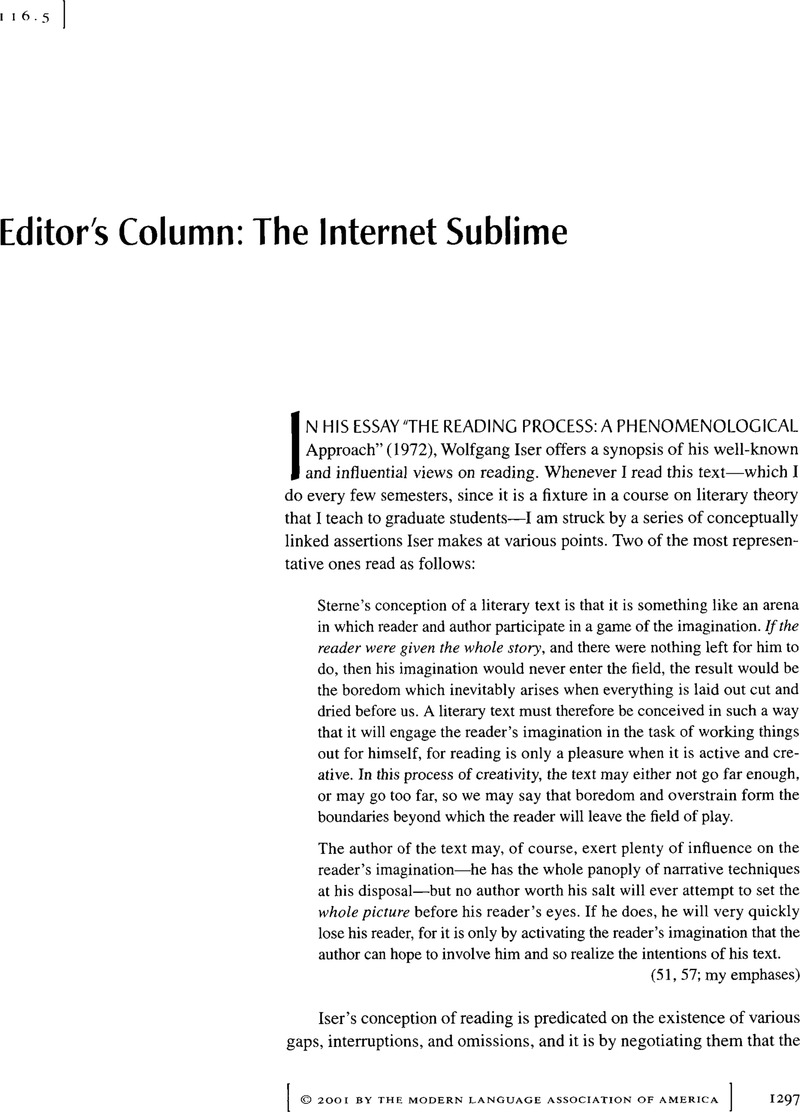No CrossRef data available.
Article contents
Editors Column: The Internet Sublime
Published online by Cambridge University Press: 23 October 2020
Abstract
An abstract is not available for this content so a preview has been provided. As you have access to this content, a full PDF is available via the ‘Save PDF’ action button.

Information
- Type
- Editorial
- Information
- Copyright
- Copyright © Modern Language Association of America, 2001
References
Works Cited
Aviles, Luis F. “Tecnofilia y fin de siglo: Hermes, o el viajero virtual.” Latin American Literary Review 27.2 (1999): 68–79.Google Scholar
Barthes, Roland. “The Death of the Author.” Image-Music-Text. Trans. Stephen Heath. New York: Hill, 1977. 142–48.Google Scholar
Birkerts, Sven. The Gutenberg Elegies: The Fate of Reading in an Electronic Age. Boston: Faber, 1994.Google Scholar
Culler, Jonathan. “Presupposition and Intertextuality.” The Pursuit of Signs: Semiotics, Literature, Deconstruction. Ithaca: Cornell UP, 1981. 100–18.Google Scholar
Iser, Wolfgang. “The Reading Process: A Phenomenological Approach.” Reader-Response Criticism: From Formalism to Post-structuralism. Ed. Tompkins, Jane. Baltimore: Johns Hopkins UP, 1980. 50–69.Google Scholar
McGann, Jerome. “Radiant Textuality.” 10 Feb. 1996. Inst. for Advanced Technology in the Humanities. 23 July 2001 <http://jefferson.village.virginia.edu/public/jjm2f/radiant.html>..>Google Scholar
McGann, Jerome. “The Rationale of HyperText.” 6 May 1995. Inst. for Advanced Technology in the Humanities. 23 July 2001 <http://jefferson.village.virginia.edu/public/jjm2f/rationale.html>..>Google Scholar
Stone, Allucquère R. The War of Desire and Technology at the End of the Mechanical Age. Cambridge: MIT P, 1995.Google Scholar
Turkle, Sherry. Life on the Screen: Identity in the Age of the Internet. New York: Simon, 1995.Google Scholar
Unsworth, John. “Electronic Scholarship; or, Scholarly Publishing and the Public.” 1 Oct. 1996. Inst. for Advanced Technology in the Humanities. 23 July 2001 <http://www.iath.virginia.edu/~jmu2m/mla-94.html>..>Google Scholar

